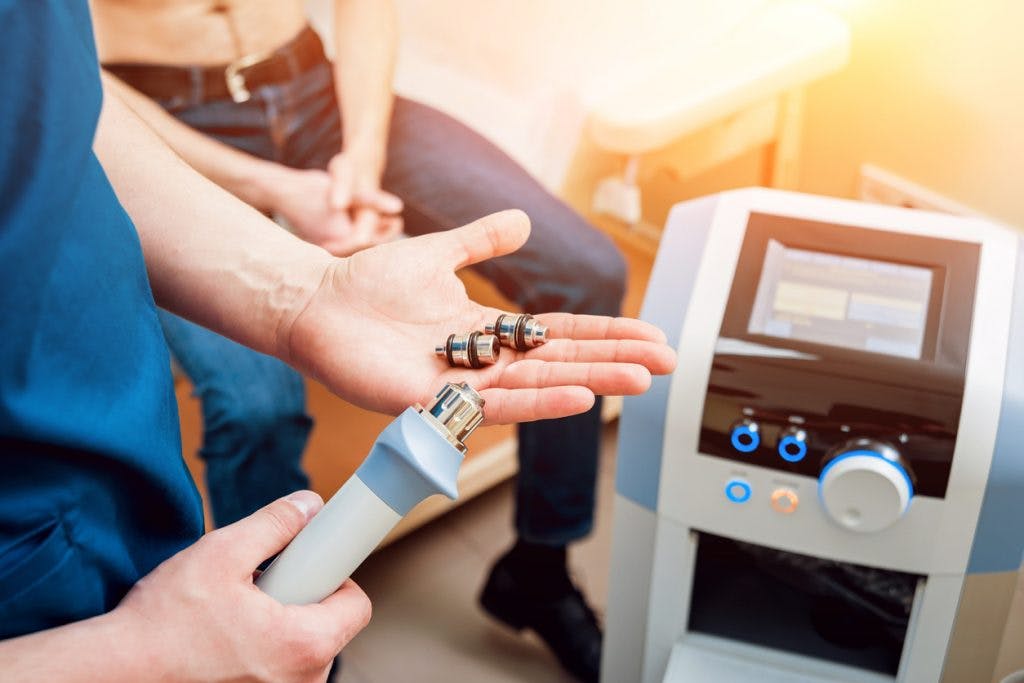There is a growing body of evidence regarding the effectiveness of cold laser therapy as a potential treatment for traumatic brain injury. Research has shown that cold laser therapy has multiple benefits, including boosting cognitive function and improving wellbeing.
This article will review the benefits and drawbacks of using cold laser therapy to treat brain injury, including an overview of several studies focused on its effectiveness. Use the links below to jump directly to any section:
- What is cold laser therapy?
- How does cold laser therapy work?
- Evidence supporting cold laser therapy for TBI
- Criticisms of cold laser therapy
What is Cold Laser Therapy for Brain Injury?
Also known as low-level laser therapy or photobiomodulation, cold laser therapy uses low-intensity lasers to stimulate the body’s natural healing process. The lasers are considered “cold” because they do not emit heat or burn tissue as other lasers do. In fact, the procedure is completely painless and non-invasive.
Since cold laser therapy is currently only approved by the FDA to treat whole body pain, it is mainly used by therapists as a form of pain relief. With more research, it could be approved for other uses in the future.
In fact, it has been suggested that cold laser therapy could be used to treat other conditions such as traumatic brain injury, stroke, Alzheimer’s, and major depressive disorder. This is likely due to its ability to reduce neuroinflammation, promote nerve and tissue healing, and encourage neurogenesis (the formation of new nerve cells).
Of note, there are other light-based therapies available that use LED lights rather than laser diodes. While the research in this area is also increasing, low-level light therapy using LEDs has shown similar results as cold laser therapy for addressing brain injury.
How Does Cold Laser Therapy Work?

Cold laser therapy is performed by gently pressing a small laser-emitting device directly over the targeted area of the body. This allows infrared and/or near-infrared light to penetrate the skin and be absorbed by deeper tissues.
The absorbed infrared light triggers a number of physiological responses involved in healing. This includes increasing blood flow, boosting energy production, and inducing neuroprotective responses. The treatment is non-invasive and adverse side effects are rare, making cold laser therapy a favorable alternative to other types of treatments.
Different frequency and wavelength parameters are used for different treatments. For example, a few studies have found that pulsed wave laser treatments are more effective for improving brain injury outcomes than using continuous wave mode.
Furthermore, while wavelengths of 600-1100nm may be used, a couple of studies have recommended using a wavelength of 810nm to target brain tissues after traumatic brain injury. Researchers are continuing to investigate the optimal parameters for promoting brain injury recovery.
Evidence Supporting Cold Laser Therapy for TBI Survivors
There have been several studies conducted on individuals with traumatic brain injuries that suggest cold laser therapy may be beneficial. The findings of a few of these studies are below:
- Improves Alertness and Awareness. This 2015 study examined the effects of cold laser therapy on five severe TBI survivors in the subacute or chronic stages of recovery.After 30 treatment sessions, each individual demonstrated improvements in awareness of their surroundings and level of alertness according to the Revised Coma Recovery Scale.
- Promotes Neuropsychological Outcomes, Mood, and Well-Being. A 2022 study looking at the effects of cold laser therapy on 11 TBI survivors found that the treatment had a positive effect on their emotional state and neuropsychological test results. Furthermore, survivors receiving cold laser treatment reported significantly improved well-being.
- Boosts Cognitive Functions. A 2017 study focused on cognitive functions in older adults found cognitive speed and accuracy improved among three individuals with mild TBI after five cold laser therapy sessions.
These are just a few examples of the benefits that traumatic brain injury survivors have seen from cold laser therapy. Most studies currently available have small sample sizes, thus the results are not as strongly conclusive. As the effects of cold laser therapy on traumatic brain injury continue to be examined, researchers may be able to form a stronger conclusion regarding the effectiveness of the treatment.
Criticisms of Cold Laser Therapy
With this in mind, most critics of cold laser therapy argue that the scientific studies supporting it are weak. Many of the studies have a small number of participants, focus only on short-term outcomes, and do not include adequate controls.
In addition, there are drastic differences between studies in regards to dosage and administration parameters that make it difficult to identify an ideal treatment protocol. The recommended number of cold therapy sessions, time required per session, and optimal treatment parameters vary greatly.
Despite the lack of strong evidence, it is possible that cold laser therapy may be an effective traumatic brain injury treatment. The results of current studies are very promising, and have demonstrated that cold laser therapy may promote many of the physiological processes involved in brain injury recovery. However, in order to become widely recommended by the medical community, more extensive research is needed.
Understanding Cold Laser Therapy for Brain Injury
It is important for survivors to talk with their physical therapist or other medical specialists before starting cold laser therapy. Even though cold laser units are sold online for home use, not all the units are of equal quality. Many therapists will be able to recommend which device may work best, and may be aware of the most recent updates regarding their effectiveness.
While research on cold laser treatment for brain injury is still ongoing, there have been promising results. Since it is a painless, non-invasive treatment with very limited potential side effects, it could be ideal for those looking for an alternative method to reduce brain injury symptoms.
The post Cold Laser Therapy for Brain Injury: What It Is, How It Works, & More appeared first on Flint Rehab.



